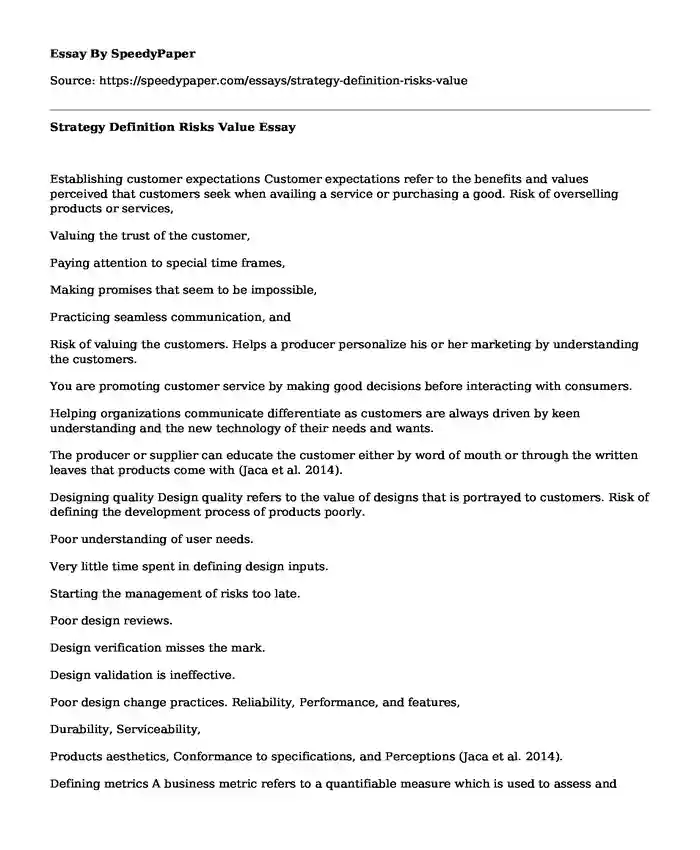
| Essay type: | Definition essays |
| Categories: | Culture Health and Social Care Human resources |
| Pages: | 3 |
| Wordcount: | 650 words |
Establishing customer expectations Customer expectations refer to the benefits and values perceived that customers seek when availing a service or purchasing a good. Risk of overselling products or services,
Valuing the trust of the customer,
Paying attention to special time frames,
Making promises that seem to be impossible,
Practicing seamless communication, and
Risk of valuing the customers. Helps a producer personalize his or her marketing by understanding the customers.
You are promoting customer service by making good decisions before interacting with consumers.
Helping organizations communicate differentiate as customers are always driven by keen understanding and the new technology of their needs and wants.
The producer or supplier can educate the customer either by word of mouth or through the written leaves that products come with (Jaca et al. 2014).
Designing quality Design quality refers to the value of designs that is portrayed to customers. Risk of defining the development process of products poorly.
Poor understanding of user needs.
Very little time spent in defining design inputs.
Starting the management of risks too late.
Poor design reviews.
Design verification misses the mark.
Design validation is ineffective.
Poor design change practices. Reliability, Performance, and features,
Durability, Serviceability,
Products aesthetics, Conformance to specifications, and Perceptions (Jaca et al. 2014).
Defining metrics A business metric refers to a quantifiable measure which is used to assess and track the status of a particular business process. Risk of exposure.
Uncertainty.
Time.
Objectives.
Variance deviation.
Drive performance
Drive the direction and strategy of an organization or company,
Help in making decisions,
Provide a focus for an employee, department or organization,
Evolution and change with the organization, and
Production of good external and internal public relations (Stevenson, Hojati, & Cao, 2017).
Mistake-proofing Mistake proofing refers to the use of an automatic method or device that makes it impossible for any error to take place or one that makes an error to be seen immediately once it has occurred. Risk of shutdown or stopping a process immediately a failure occurs,
Control risk that eliminates failure occurrence in a method and warning risks that proactively notifies the failure occurrence in a process before it takes place. Fewer mistakes made as the process is always reliable, clear postings of instructions of operation save on time and retrieval, and efficiency (Jaca et al. 2014).
Kaizen Kaizen refers to the continuous improvement of one's personal life, working life, social life or home life. Lack of return, the flavor of the mouth, lip service from the supervisors and the top management, and risk of a continuous flow. Waste reduction, positive productivity, results in orientation, quality, accuracy, cost advantage, competitive advantage, safety, empowerment, happy workplace, satisfaction, and continuous improvement by providing a large number of opportunities for firms to improve (Stevenson, Hojati, & Cao, 2017).
Six Sigma Six Sigma refers to a set of management techniques that are intended to improve the processes of businesses by reducing the probability of an error or defection from occurring greatly. Lack of consistent training, lack of transparency, lack of organization, an abundance of illegitimate training and growth of poor reputations. Excellent time management that results in productive employees and efficient business, improved customer loyalty by reducing the risks of having customers who are not satisfied, employee motivation by fully engaging the workers which increase productivity, reduced cycle time where experienced employees find quick possible solutions to problems, strategic planning by eliminating unnecessary complexity. Also, supply chain management by decreasing the number of suppliers that any business may have (Jiju, Ronald, & Roger, 2017).
References
Jaca, C., Viles, E., Paipa-Galeano, L., Santos, J., & Mateo, R. (2014). Learning 5S principles from Japanese best practitioners: Case studies of five manufacturing companies. International Journal of Production Research, 52(15), 4574-4586. Doi: 10.1080/00207543.2013.878481
Jiju, A., Ronald, S., & Roger, H. (2017) "Lean Six Sigma: yesterday, today and tomorrow," International Journal of Quality & Reliability Management, Vol. 34 Issue: 7, pp.1073-1093. Doi: 10.1108/IJQRM-03-2016-0035
Stevenson, W. J., Hojati, M., & Cao, J. (2017). Operations management (Vol. 8). Boston: McGraw-Hill/Irwin.
Cite this page
Strategy Definition Risks Value. (2022, Dec 13). Retrieved from https://speedypaper.com/essays/strategy-definition-risks-value
Request Removal
If you are the original author of this essay and no longer wish to have it published on the SpeedyPaper website, please click below to request its removal:
Popular categories




